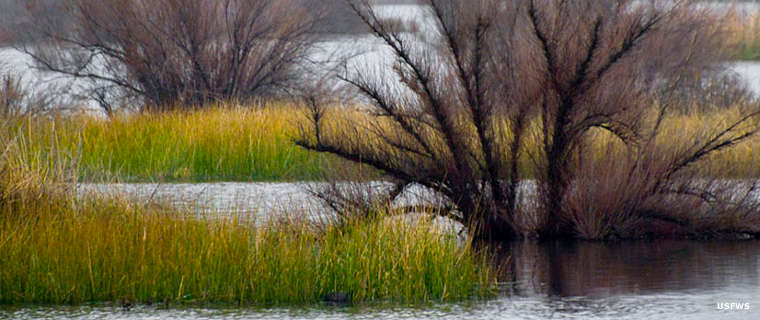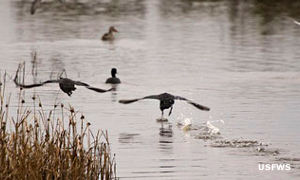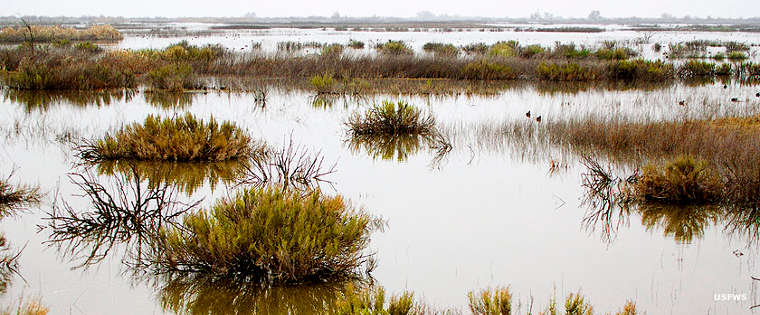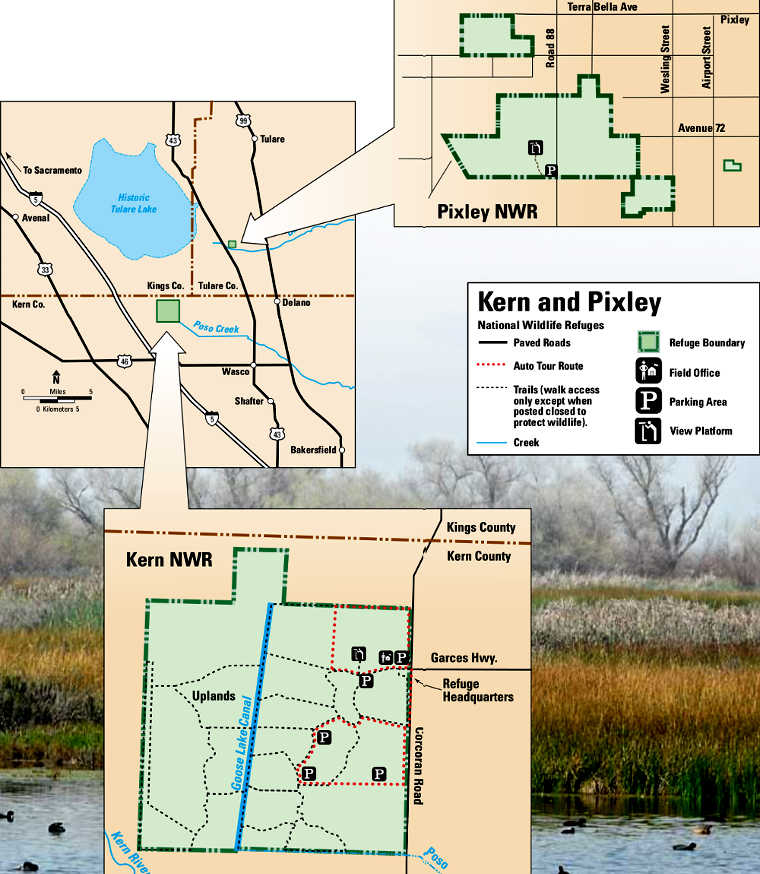Kern National Wildlife Refuge

In the wetlands at Kern National Wildlife Refuge
 Waterfowl in the wetlands
Waterfowl in the wetlandsFor thousands of years after the last Ice Age ended, the San Joaquin Valley of central California was home to more than 800,000 acres of natural wetlands. The largest fresh-water marsh on the West Coast, Lake Tulare in the San Joaquin Valley also played host to hundreds of thousands of migratory waterfowl every spring and fall. In the mid-1800's hunters flocked to the area to get food for the tables of San Francisco and Los Angeles. Then water control projects began to take hold upstream and the inflows to Lake Tulare stopped. That led to a 98% reduction in wetland acreage in the valley and a corresponding reduction in the number of migratory birds passing through.
The 11,249-acre Kern National Wildlife Refuge was established in 1960 on the southern edge of what once was Lake Tulare. The refuge mission was to preserve and protect some of the last remaining wetlands in the valley. However, it wasn't until the Central Valley Project Improvement Act was passed in 1992 that the refuge got a reliable water supply. Today, the water control structures are set to begin the fall flood-up of the refuge in mid-August. That usually means that by January nearly 6,500 acres of the property have become marsh again. That high water level is usually maintained through February before it is allowed to slowly drain away. Selected units of the property receive regular water flows into mid-summer to stimulate growth of plants to feed migrating birds in the fall. About 2,300 acres of Kern National Wildlife Refuge are classified as moist soil areas, wet areas covered by less than 6 inches of water. Moist soil areas are highly productive with swamp timothy, sprangletop and watergrass. About 4,200 acres of Kern NWR are classified as seasonal marsh units with water levels that vary from a couple inches to 4 feet deep. These are habitats where burhead, hard-stem bullrush and cattail reign. The drier upland areas of the refuge (about 3,600 acres) are usually closed to the public because they provide habitat for threatened and endangered species like the Tipton kangaroo rat, the blunt nosed leopard lizard and the San Joaquin kit fox. The uplands are a mix of alkali playa, valley sink scrub and grassland.
Kern National Wildlife Refuge is a day-use only property, open daily from sunrise to sunset. The refuge offers a 6.5-mile auto tour route through the refuge on an all-weather gravel road. There are three parking areas along the route but stopping is allowed anywhere. The route is closed on Wednesdays and Saturdays during waterfowl hunting season, October through January. Motor vehicles are allowed only on posted tour routes. Hiking is allowed on any road, dike and levee on the property, except in areas posted as closed. No formal nature trails exist but there are plenty of secondary roads and dikes to hike to get to places less visited. The best time to visit and see birds is from October through March when there are more than 220 species using the property. There are several species of snakes on the property, including the western rattlesnake. You'll want industrial strength bug spray as the West Nile and Western Equine Encephalitis viruses are present on the refuge.
Non-motorized boats are allowed only in active hunting areas during waterfowl hunting season. Motorized boats are not allowed, nor are non-motorized boats allowed outside of active hunting areas during hunting season. Biking is allowed only on designated public access routes. Bikes are not allowed on trails or roads closed to horses or vehicles. Horseback riding is allowed only on signed public access roads open to motor vehicles.
The Kern National Wildlife Refuge office is open Monday through Friday, 7 am to 4:30 pm, except closed on Federal holidays.

More wetlands

Photos and maps courtesy of the US Fish & Wildlife Service